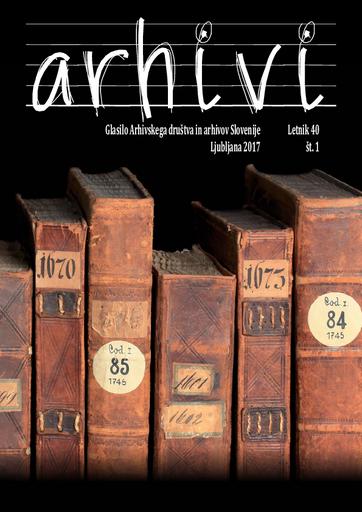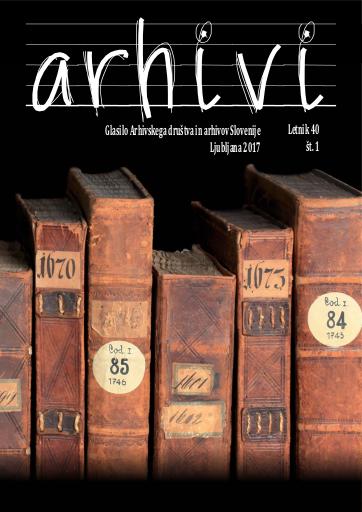/
Serijske publikacije
/
Arhivi
Popis srajčk neobjavljenih oddaj v Arhivu TV Slovenija

Avtor(ji):Aleksander Lavrenčič
Soavtor(ji):Gregor Jenuš (gl. in odg. ur.), Dunja Mušič (teh. ur.), Petra Markuš (lekt.), Petra Markuš (prev.), Nina Gostenčnik, Sabina Lešnik (foto.)
Leto:2017
Založnik(i):Arhivsko društvo Slovenije, Ljubljana
Vir(i):Arhivi, 2017, št. 1
Jezik(i):slovenščina
Vrst(e) gradiva:besedilo
Ključne besede:IZ ARHIVSKIH FONDOV IN ZBIRK, Televizija Slovenija, avdiovizualni arhivi, televizijski arhivi, FROM THE ARCHIVAL FILES AND COLLECTIONS, TV Slovenia, audio-visual archives, television archives
Avtorske pravice:

To delo avtorja Aleksander Lavrenčič je ponujeno pod Creative Commons Priznanje avtorstva-Nekomercialno-Deljenje pod enakimi pogoji 4.0 Mednarodna
Datoteke (1)

Ime:ARHIVI_2017-1.pdf
Velikost:4.49MB
Format:application/pdf
Stalna povezava:https://hdl.handle.net/11686/file25396
Opis
Avtor v prispevku opisuje postopek evidentiranja besedil neobjavljenih oddaj v Arhivu TV Slovenija. Vsa oddana besedila oddaj, ki še niso bile objavljene, so pregledali in napravili popis v novi zbirki. Popis omogoča lažje iskanje oddaj in njihovo objavo. Po končanem popisu oziroma evidentiranju oddaj čaka zaposlene v arhivu naslednji korak – digitalizacija evidentiranih neobjavljenih oddaj in varna hramba izvirnikov v skladišču.
Metapodatki (12)
- identifikatorhttps://hdl.handle.net/11686/41473
- naslov
- Popis srajčk neobjavljenih oddaj v Arhivu TV Slovenija
- Inventory of the Unreleased Broadcasts Folders in the TV Slovenia Archive
- ustvarjalec
- Aleksander Lavrenčič
- soavtor
- Gregor Jenuš (gl. in odg. ur.)
- Dunja Mušič (teh. ur.)
- Petra Markuš (lekt.)
- Petra Markuš (prev.)
- Nina Gostenčnik, Sabina Lešnik (foto.)
- predmet
- IZ ARHIVSKIH FONDOV IN ZBIRK
- Televizija Slovenija
- avdiovizualni arhivi
- televizijski arhivi
- FROM THE ARCHIVAL FILES AND COLLECTIONS
- TV Slovenia
- audio-visual archives
- television archives
- opis
- Our objective was to record folders of unreleased broadcasts and compile a new collection. The second objective was to ensure transparency of unreleased broadcast folders that enable better cooperation with editorial staff. The improved cooperation will allow the release of the forgotten broadcasts. We have also examined past archive processes. The main objective of the process overview was to find good practices and past mistakes. We were aware of the need to continue the good work also with digital preservation. Recognition of the past errors will help us avoid mistakes in the future. However, knowledge should be imparted to the new generations. After the changes of the archiving method, that is after the transition to the archiving of digital files and programming documents in electronic form in the new program »Adam«, the folders of unreleased broadcasts that were stored in the archives along with the folders of already published broadcasts stayed forgotten. We’ve stopped using the old archiving program »Eva« and, consequently, collection »MGS« was closed and available only in exceptional circumstances. Individualtapes found in closet corners and desk drawers were still brought to the archive. We have therefore decided to create a new collection »XMGS« where we put the folders of unreleased shows on tapes thus making them accessible for searching. The procedure has been carried out according to established rules of work in television archive. We created a new collection »XMGS«, the collection of unreleased broadcasts on tapes which provides an overview of folders submitted in stock – immediately after the finalization of the broadcast. To awake or to show these broadcasts, proper inventory should be accomplished to provide transparency in the collection. The transparency in the searching unreleased broadcasts enables us to release them. Upon the formation of the new collection we recorded all our procedures. This is all the more necessary given the closing of a certain chapter in the history of television archiving. At the abandonment of work with program »Eva« we decided to record all our procedures and archiving instructions and thus transfer the knowledge of the former method of archiving to the next generations. It should be pointed out in this respect that good practices must continue also in digital environment, however, past mistakes which occurred in the process should also be noted to avoid their repetition. In this way, we helped the media archaeology, a new discipline which has had strong development recently. The next step awaits after completing the inventory – the digitalisation of inventoried unreleased broadcasts and safe keeping of originals in the storage.
- založnik
- Arhivsko društvo Slovenije
- datum
- 2017
- 01. 01. 2017
- tip
- besedilo
- jezik
- Slovenščina
- jeDelOd
- pravice
- licenca: ccByNcSa
